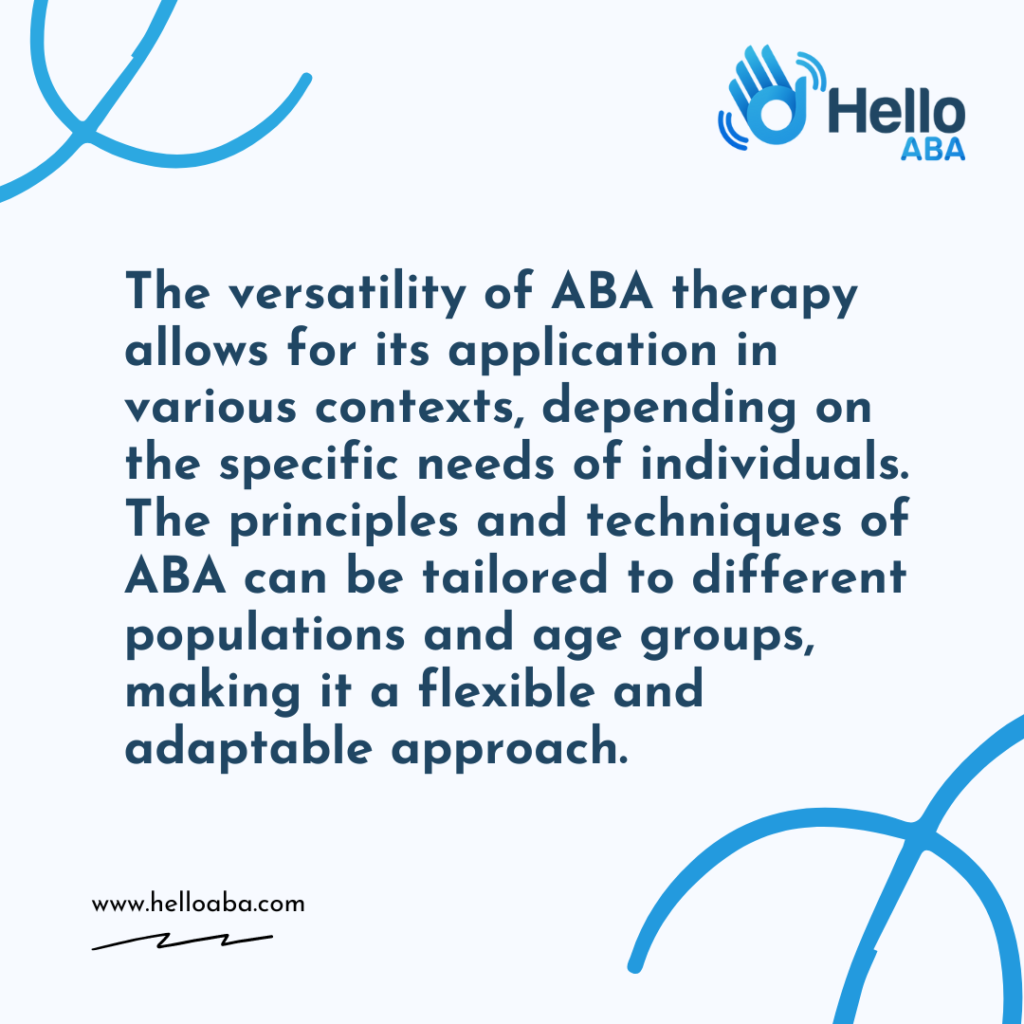Applied Behavior Analysis, or ABA, therapy is a widely used approach for improving skills and behaviors. While often associated with autism spectrum disorder (ASD), ABA therapy can benefit a much broader range of individuals. This article explores who can benefit from ABA therapy, diving into the conditions it helps and how it can improve overall quality of life.
What is ABA Therapy?
ABA therapy is a comprehensive and individualized approach that focuses on understanding the factors that influence behavior and implementing interventions to bring about meaningful changes. It involves breaking down complex skills into smaller, manageable steps and using positive reinforcement to encourage desired behaviors.
The therapy is highly structured and data-driven, with a strong emphasis on systematic observation and measurement of behavior. ABA therapists work closely with individuals, typically in one-on-one sessions, to assess their unique needs and develop customized treatment plans.

Principles of ABA Therapy
ABA therapy is guided by several core principles that form the foundation of this therapeutic approach. These principles include:
- Positive Reinforcement: The intervention utilizes positive reinforcement techniques to increase the likelihood of desired behaviors being repeated. This can involve providing rewards or praise when individuals demonstrate the desired behavior.
- Prompting and Prompt Fading: ABA professionals use prompts, like verbal cues or physical guidance, to assist individuals in carrying out a desired behavior. Over time, these cues or prompts are gradually faded out to promote independent behavior.
- Generalization: ABA therapy aims to facilitate the generalization of skills across different settings and contexts. Individuals are encouraged to apply learned behaviors and skills in various environments, ensuring that they can use them effectively in real-life situations.
- Data Collection and Analysis: Therapists collect data on behaviors and interventions to track progress and make informed decisions about treatment strategies. This data-driven approach helps therapists to objectively gauge the effectiveness of ABA therapy and make adjustments as necessary.
- Individualization: ABA therapy recognizes that each individual has unique needs and tailors the treatment accordingly. Personalized goals are established based on an individual’s specific challenges and strengths, allowing for a targeted and individualized approach to therapy.
ABA therapy has been extensively researched and has shown significant effectiveness in treating individuals with autism. It has been found to increase helpful behaviors, decrease harmful behaviors, teach communication and social skills, improve developmental skills, and reduce inappropriate behaviors.

Who Benefits from ABA Therapy
The target audience for ABA therapy includes individuals diagnosed with autism spectrum disorder (ASD). ABA therapy is beneficial for individuals across the spectrum, from mild to severe cases. It is also suitable for individuals with other developmental disorders, such as attention-deficit/hyperactivity disorder (ADHD), intellectual disabilities, and language disorders.
ABA therapy is particularly valuable for children with autism. Early intervention using ABA principles has shown significant developmental gains, helping children acquire essential skills and improve their overall quality of life. However, it’s important to note that ABA therapy is not limited to children. It can also be beneficial for adults with autism who may require support in developing social skills, communication, and independent living skills.
Age Groups for ABA Therapy
For children, starting ABA therapy as early as possible can lead to substantial developmental gains. Research has shown that intensive and long-term ABA therapy can significantly improve outcomes for many children with autism. Studies have demonstrated that children who undergo intensive ABA therapy for 25 to 40 hours per week for one to three years demonstrate positive outcomes, including gains in communication, social skills, and daily living skills.
For older children, adolescents, and adults, ABA therapy can help enhance social skills, promote independent living, and improve overall quality of life. It can provide individuals with the tools and strategies necessary to navigate social interactions, manage emotions, and develop essential life skills. ABA therapy is a valuable resource at any age.
In summary, ABA therapy is beneficial for individuals diagnosed with autism and other developmental disorders. It caters to individuals of all ages, from early childhood through adulthood.
Effectiveness of ABA Therapy
Success Stories with ABA
The success stories of individuals who have undergone ABA therapy provide further evidence of its effectiveness. Many parents and caregivers have witnessed remarkable progress in their children’s development after implementing ABA interventions.
One notable example is the book “Let Me Hear Your Voice” by Catherine Maurice, which tells the story of two children diagnosed with autism who made significant strides with behavioral interventions, including ABA therapy. This book and others like it have inspired hope and shed light on the potential of ABA therapy for individuals with autism.
Furthermore, studies have shown that children who receive intensive, long-term ABA therapy for 25 to 40 hours per week over one to three years demonstrate positive outcomes. These outcomes include gains in communication skills, social skills, and daily living skills.
ABA therapy provides children on the autism spectrum with the tools to adapt to social scenarios they may not understand. By utilizing positive reinforcement techniques, ABA therapy rewards desired behaviors, increasing the chances of those behaviors being sustained and repeated over time.
The research and success stories surrounding ABA therapy highlight its effectiveness in improving outcomes for individuals with autism. With its evidence-based approach and personalized goals, ABA therapy has proven to be a valuable intervention for individuals on the autism spectrum.

Applications of ABA Therapy Beyond Autism
While ABA therapy is most commonly associated with autism, its principles and techniques have been utilized successfully in other areas as well. ABA therapy has been applied in the treatment of individuals with traumatic brain injuries, helping them regain and develop important skills for daily living. In educational settings, ABA techniques have been employed to support students with various learning and behavioral challenges.
The intervention has also been applied in sports psychology, helping athletes improve performance by modifying behaviors and developing effective strategies. Additionally, ABA techniques have been utilized in health and fitness settings to promote healthy habits and behavior change. Even substance abuse disorders have been addressed using ABA therapy approaches, assisting individuals in overcoming addiction and establishing healthier lifestyles.
Diverse Contexts for ABA
ABA therapy can also be beneficial for adults with developmental disabilities or those seeking support in managing challenging behaviors. Parents and caregivers can also benefit from ABA therapy training, equipping them with strategies to effectively support their loved ones with autism or other behavioral challenges. By understanding the underlying principles of behavior analysis, parents and caregivers can create a supportive environment and reinforce positive behaviors.
Recognizing the broader applications of ABA therapy allows individuals outside the autism community to benefit from its evidence-based techniques. Whether in educational settings, sports psychology, health and fitness, or substance abuse treatment, ABA therapy provides a structured and effective framework for behavior modification and skill development.

Personalized Approach in ABA
In ABA therapy, each child’s treatment plan is tailored to their specific struggles and developmental needs. This personalized approach recognizes that every individual with autism is unique and may require different areas of focus. By setting individualized goals, ABA practitioners can target specific behaviors and skills that need improvement.
These goals can range from developing communication and social skills to reducing challenging behaviors and promoting independence in daily living skills. The flexibility of ABA therapy allows for adjustments in goals as the child progresses or faces setbacks over time. Continuous assessment and reassessment of the child’s progress enable practitioners to adapt the therapy to meet the child’s changing needs.
ABA practitioners closely observe and analyze the child’s behaviors and responses to interventions, allowing for real-time adjustments in the therapy approach. By closely monitoring the child’s progress, practitioners can modify strategies, techniques, and reinforcement methods to ensure optimal learning and skill development. This adaptability helps to create a supportive and engaging environment for the child, maximizing their potential for progress.
Furthermore, ABA therapy emphasizes consistency and generalization of learned skills. The skills acquired during therapy sessions are practiced and reinforced across various settings, such as home, school, and community. This approach helps individuals with autism generalize their newly acquired skills to real-life situations, promoting meaningful and lasting change.
Impact on Individuals with Autism
ABA therapy has the power to make a significant impact on the lives of individuals with autism. ABA therapists work closely with individuals to identify and target specific goals based on their unique needs and abilities. Furthermore, ABA therapy helps combat the tyranny of low expectations. Individuals with autism often face societal limitations and stereotypes that can hinder their progress. ABA therapy empowers individuals with autism by providing them with the tools and strategies to overcome these challenges. By focusing on building essential skills and fostering independence, ABA therapy ensures that individuals with autism are not limited by society’s views and are given the opportunity to learn and grow. The scientific evidence supporting ABA therapy is extensive and shows its effectiveness in improving various aspects of a person’s life. Through personalized interventions and evidence-based methodologies, ABA therapy can help individuals with autism achieve their fullest potential. If you are looking for ABA therapy in Maryland, Hello ABA offers top-notch services. Contact us or book an appointment today to learn more about how we can support you and your loved ones.






